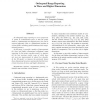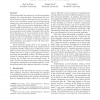494 search results - page 6 / 99 » Modeling and predicting pointing errors in two dimensions |
ISMAR
2006
IEEE
14 years 1 months ago
2006
IEEE
Marker-based optical tracking systems are widely used in augmented reality, medical navigation and industrial applications. We propose a model for the prediction of the target reg...
FOCS
2009
IEEE
14 years 2 months ago
2009
IEEE
In orthogonal range reporting we are to preprocess N points in d-dimensional space so that the points inside a d-dimensional axis-aligned query box can be reported efficiently. T...
SBACPAD
2008
IEEE
14 years 2 months ago
2008
IEEE
Transactional memory is emerging as a parallel programming paradigm for multi-core processors. Despite the recent interest in transactional memory, there has been no study to char...
EMNLP
2008
13 years 9 months ago
2008
Predicting possible code-switching points can help develop more accurate methods for automatically processing mixed-language text, such as multilingual language models for speech ...
SODA
2008
ACM
13 years 9 months ago
2008
ACM
DNA self-assembly has emerged as a rich and promising primitive for nano-technology. Experimental and analytical evidence indicates that such systems are prone to errors, and acco...


